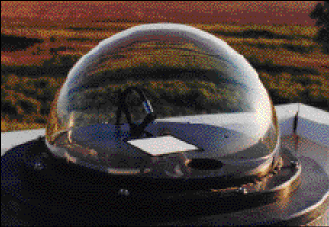R. Winn Hardin
LAMONT, Okla. -- Several design improvements including a reflective instead of transmissive light diffuser panel and fiber optic probe should help the US Department of Energy (DoE) better understand how radiation in the atmosphere affects weather patterns.
The interaction of clouds and sunlight greatly impacts weather patterns, according to the DoE's Atmospheric Radiation Measurement program. A new spectroradiometer under development at Analytical Spectral Devices Inc. of Boulder, Colo., will allow scientists to measure this interaction by observing a larger part of the visible and IR spectrum in real time.

Among other benefits, the diffuser panel used in Analytical's improved spectroradiometer eliminates the need for complicated algorithms that compensate for weather and the time of day.
|
The specially designed FieldSpec FR spectroradiometer uses a diffuser panel instead of an integrating sphere. Most spectroradiometers measure electromagnetic radiation by measuring the light bouncing off the inside walls of a large globe, or integrating sphere. Light enters the sphere through a small aperture. The ratio between the aperture and the surface area of the globe helps determine the signal strength, often as low as 1/100 of the original intensity.
The new design uses a diffuser panel. Sunlight reflects off the top of the diffuser panel, and a fiber optic probe carries it to a set of detectors optimized for wavelengths between 350 and 2500 nm. Spectroradiometers that use diffusers measure the transmitted light. Depending on the material, however, the diffuser absorbs parts of the spectrum.
"These [transmitting diffusers] are used across narrow spectral devices, less than a couple of hundred nanometers," said Brian Curtiss, a system developer at the Boulder company.
Smaller probes, bigger signals
A fiber optic probe positioned above the diffuser panel extends the system's light budget. The probe allows designers to place the device some distance from the diffusing panel. Additionally, placing the probe to the north ensures that all the sunlight will reach the diffusing panel, an important consideration when studying cloud/sunlight interaction.
By combining the two techniques, Curtiss estimates a tenfold improvement in signal strength. Increased signal-to-noise ratios bring another benefit: quicker measurements. Jeff Griffin, instrument mentor for the DoE program, believes that the reflecting design goes in the right direction, but adds that time will tell if the diffusing material holds a flat spectral line that remains stable.